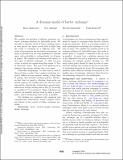A dynamic model of barter exchange
Author(s)
Kanoria, Yash; Anderson, Ross Michael; Ashlagi, Itai; Gamarnik, David
DownloadGamarnik_A dynamic model.pdf (374.5Kb)
PUBLISHER_POLICY
Publisher Policy
Article is made available in accordance with the publisher's policy and may be subject to US copyright law. Please refer to the publisher's site for terms of use.
Terms of use
Metadata
Show full item recordAbstract
We consider the problem of efficient operation of a barter exchange platform for indivisible goods. We introduce a dynamic model of barter exchange where in each period one agent arrives with a single item she wants to exchange for a different item. We study a homogeneous and stochastic environment: an agent is interested in the item possessed by another agent with probability p, independently for all pairs of agents. We consider two settings with respect to the types of allowed exchanges: a) Only two-way cycles, in which two agents swap their items, b) Two or three-way cycles. The goal of the platform is to minimize the average waiting time of an agent.
Somewhat surprisingly, we find that in each of these settings, a policy that conducts exchanges in a greedy fashion is near optimal, among a large class of policies that includes batching policies. Further, we find that for small p, allowing three-cycles can greatly improve the waiting time over the two-cycles only setting. Specifically, we find that a greedy policy achieves an average waiting time of Θ(1/p2) in setting a), and Θ(1/p3/2) in setting b). Thus, a platform can achieve the smallest waiting times by using a greedy policy, and by facilitating three cycles, if possible.
Our findings are consistent with empirical and computational observations which compare batching policies in the context of kidney exchange programs.
Date issued
2015Department
Massachusetts Institute of Technology. Operations Research Center; Sloan School of ManagementJournal
Proceedings of the Twenty-Sixth Annual ACM-SIAM Symposium on Discrete Algorithms
Publisher
Society for Industrial and Applied Mathematics (SIAM)
Citation
Anderson, Ross; Ashlagi, Itai; Gamarnik, David and Kanoria, Yash. “A Dynamic Model of Barter Exchange.” Proceedings of the Twenty-Sixth Annual ACM-SIAM Symposium on Discrete Algorithms (2015): 1925–1933. © 2015 Society for Industrial and Applied Mathematics (SIAM)
Version: Final published version
ISBN
978-1-61197-374-7
ISSN
978-1-61197-373-0